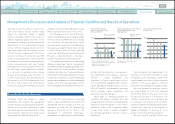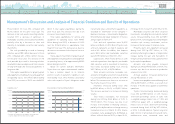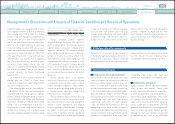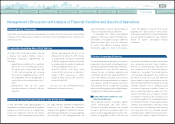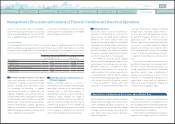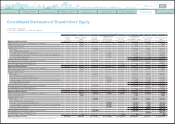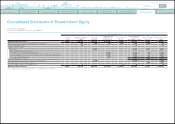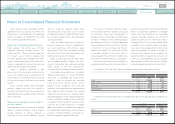Toyota 2012 Annual Report Download - page 74
Download and view the complete annual report
Please find page 74 of the 2012 Toyota annual report below. You can navigate through the pages in the report by either clicking on the pages listed below, or by using the keyword search tool below to find specific information within the annual report.
TOYOTA ANNUAL REPORT 2012
Toyota Global Vision Changes for Making
Ever-Better Cars President
ʼ
s Message Medium- to Long-Term
Growth Initiatives Special Feature Management and
Corporate Information Investor Information
Business and
Performance Review Financial Section
Management's Discussion and Analysis of Financial Condition and Results of Operations
Vehicles on operating leases, where Toyota is the
lessor, are valued at cost and depreciated over
their estimated useful lives using the straight-
line method to their estimated residual values.
Toyota utilizes industry published information
and its own historical experience to determine
estimated residual values for these vehicles.
Toyota evaluates the recoverability of the carrying
values of its leased vehicles for impairment when
there are indications of declines in residual
values, and if impaired, Toyota recognizes an
allowance for losses on its residual values.
Throughout the life of the lease, management
performs periodic evaluations of estimated
end-of-term fair values to determine whether
estimates used in the determination of the
contractual residual value are still considered
reasonable. Factors affecting the estimated
residual value at lease maturity include, but are
not limited to, new vehicle incentive programs,
new vehicle pricing, used vehicle supply,
projected vehicle return rates, and projected loss
severity. The vehicle return rate represents the
number of leased vehicles returned at contract
maturity and sold by Toyota during the period as
a percentage of the number of lease contracts
that, as of their origination dates, were scheduled
to mature in the same period. A higher rate of
vehicle returns exposes Toyota to higher potential
losses incurred at lease termination. Severity of
loss is the extent to which the end-of-term fair
estimates, in determining the residual value
losses, holding all other assumptions constant.
The following table represents the impact on the
residual value losses in Toyota
ʼ
s financial services
operations of the change in vehicle return rate
and end-of-term market values as those changes
have a significant impact on financial services
operations.
Toyota periodically reviews the carrying value of
its long-lived assets held and used and assets
to be disposed of, including intangible assets,
when events and circumstances warrant such a
review. This review is performed using estimates
of future cash flows. If the carrying value of
a long-lived asset is considered impaired, an
impairment charge is recorded for the amount by
which the carrying value of the long-lived asset
exceeds its fair value. Management believes that
the estimates of future cash flows and fair values
are reasonable. However, changes in estimates of
such cash flows and fair values would affect the
evaluations and negatively affect future operating
results of the automotive operations.
value of a lease is less than its carrying value at
lease end.
To the extent that sales incentives remain
an integral part of sales promotion, resale
prices of used vehicles and, correspondingly,
the fair value of Toyota
ʼ
s leased vehicles could
be subject to downward pressure. The extent
of the impact this will have on the end of term
residual value depends on the significance of
the incentive programs and whether they are
sustained over a number of periods. This in
turn can impact the projection of future used
vehicle values, adversely impacting the expected
residual value of the current operating lease
portfolio and increasing the provision for residual
value losses. However, various other factors
impact used vehicle values and the projection
of future residual values, including the supply
of and demand for used vehicles, interest rates,
inflation, the actual or perceived quality, safety
and reliability of vehicles, the general economic
outlook, new vehicle pricing, projected vehicle
return rates and projected loss severity, which
may offset this effect. Such factors are highly
likely to adversely affect the results of operations
for financial services due to significant charges
reducing the estimated residual value.
The following table illustrates the effect of an
assumed change in the vehicle return rate and
end-of-term market values mainly in the United
States, which Toyota believes are the critical
■
Investment in Operating Leases
■
Pension Costs and Obligations
■
Impairment of Long-Lived Assets
Natures of estimates and assumptions Natures of estimates and assumptions
Sensitivity analysis
Yen in millions
Effect on the residual
value losses over the
remaining terms of the
operating leases on and
after April 1, 2012
1 percent increase in vehicle return
rate
¥1,233
1 percent increase in end-of-term
market values
¥4,356
Pension costs and obligations are dependent on
assumptions used in calculating such amounts.
These assumptions include discount rates,
benefits earned, interest costs, expected rate
of return on plan assets, mortality rates and
other factors. Actual results that differ from the
assumptions are accumulated and amortized
over future periods and, therefore, generally
affect recognized expense in future periods. While
management believes that the assumptions used
are appropriate, differences in actual experience
or changes in assumptions may affect Toyota
ʼ
s
pension costs and obligations.
The two most critical assumptions impacting
the calculation of pension costs and obligations
are the discount rates and the expected rates
of returns on plan assets. Toyota determines
the discount rates mainly based on the rates of
high quality fixed income bonds or fixed income
governmental bonds currently available and
expected to be available during the period to
maturity of the defined benefit pension plans.
Toyota determines the expected rates of return
for pension assets after considering several
applicable factors including, the composition
of plan assets held, assumed risks of asset
management, historical results of the returns on
plan assets, Toyota
ʼ
s principal policy for plan asset
management, and forecasted market conditions.
A weighted-average discount rate of 2.8% and a
weighted-average expected rate of return on plan
0820
Search NextPrev page 74
Contents






